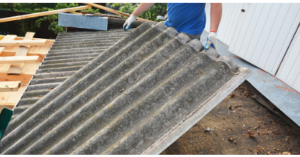Homeowners can safely complete repairs and maintenance tasks that do not disturb asbestos-containing materials; however, any work that could disturb such material must be handled by a trained contractor with experience.
 Disruption of ACM may release fibres into the air, creating an inhalation hazard. For your safety and peace of mind, licensed asbestos professionals should examine and test samples before advising on encapsulation or removal options.
Disruption of ACM may release fibres into the air, creating an inhalation hazard. For your safety and peace of mind, licensed asbestos professionals should examine and test samples before advising on encapsulation or removal options.
Detecting Asbestos
Many homes constructed before 1980 contain asbestos in various forms. It may be found in cement products, floor tiles, paints, artex, drywall insulation, pipe insulation or pipes and may cause serious health concerns when inhaled, including mesothelioma, an aggressive and potentially lethal lung cancer.
A professional, safe asbestos removal Adelaide should always conduct testing of suspect materials in your home for asbestos. However, the Environmental Protection Agency only advises testing suspect materials if they have significant signs of wear (frayed or crumbled edges or visible holes) or if you plan on undertaking renovations that could disturb them.
Asbestos can only be identified under a microscope, making it impossible to tell by looking at the material itself whether it contains this harmful element. Furthermore, unlike contaminants like gas leaks or mould growth, asbestos does not produce a distinct smell when present.
An effective approach when investigating suspicious materials is limiting access and not touching or disturbing it. If a suspicious material seems like asbestos, contact an industrial hygiene company for inspection and sampling – these professionals have extensive training handling asbestos, wearing protective suits, hoods, gloves, shoe covers and respirators while creating a clean zone between abatement areas and non-abatement spaces to avoid any contamination of non-abatement spaces.
Preparing for Removal
The asbestos abatement process can be complex, depending on which materials have been affected by its removal. One effective approach is encasing asbestos-containing material with airtight plastic covering to ensure no harmful fibres escape. It can be performed on new construction and renovation projects to protect people from inhaling harmful fibres; additionally, renovation or repair work may disturb asbestos materials such as textured ceilings, pipe insulation and floor tiles, necessitating its removal or containment for repair work purposes.
Safe asbestos removal Adelaide performing asbestos encapsulation and removal processes must be trained and licensed by MassDEP. Once in their work area, they must set up a containment area, use negative air pressure units and post warning signs to keep out unauthorised personnel; wet asbestos materials before cutting to reduce the release of fibres into the air; use HEPA air filters and clean exhaust ducts to filter the air in their work area and filter any stray fibres; finally once complete they should place asbestos into durable, airtight bags six mil thick that seal before disposing it into dumpster marked toxic/hazardous waste with an associated DTSC certificate labelled accordingly.
Removal Procedures
Asbestos should only be handled or disturbed by trained professionals as it can easily become airborne and inhaled, potentially leading to lung cancer and mesothelioma. Disturbed asbestos becomes friable and releases fibres into the air. If an asbestos fibre has not been damaged, it can usually remain undisturbed – however, major renovations in a home may necessitate its removal and encapsulation.
Before beginning work on any job, a contractor uses plastic sheeting and duct tape to separate the area from the rest of the house. Heated and cooling systems should also be turned off during abatement to keep demolition dust from spreading elsewhere in the building. Vents, windows, and exhaust ducts should also be sealed to stop demolition dust from entering other parts of the structure.
Non-friable asbestos materials may be encapsulated, which involves applying a sealant that prevents asbestos fibres from dislodging from their material and becoming airborne. Encapsulation can be safer than removal for some individuals; however, only qualified asbestos professionals should perform this service, and it should only be performed if your material hasn’t been severely damaged.
